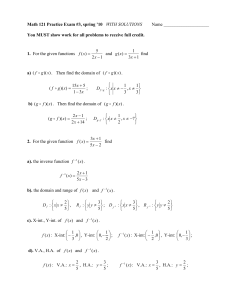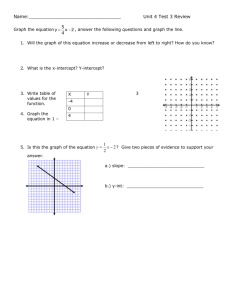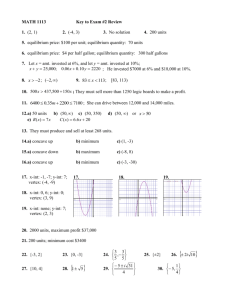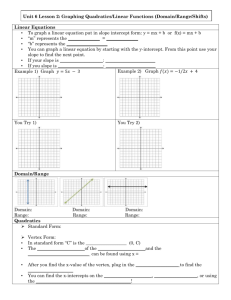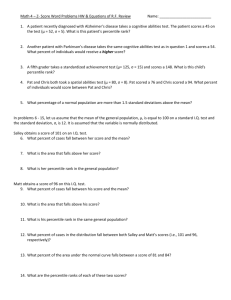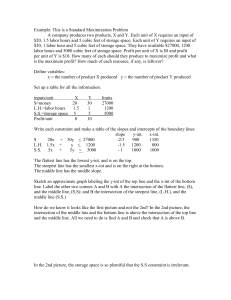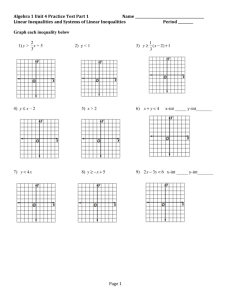Practice Exam 3: Be aware that the following problems are not
advertisement
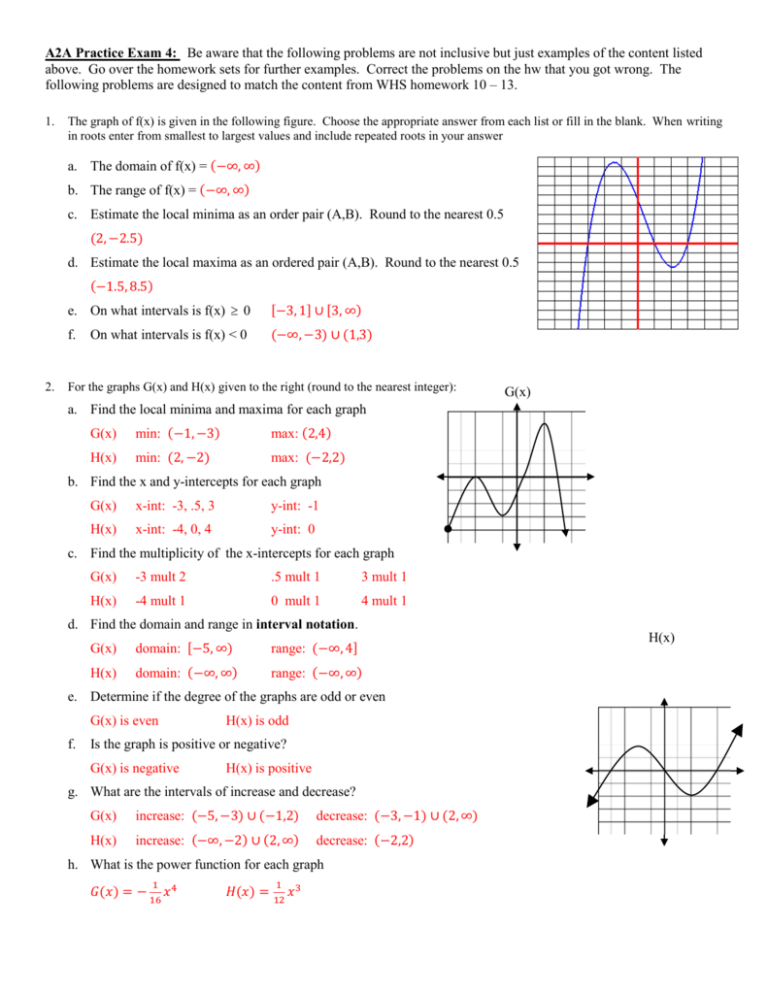
A2A Practice Exam 4: Be aware that the following problems are not inclusive but just examples of the content listed above. Go over the homework sets for further examples. Correct the problems on the hw that you got wrong. The following problems are designed to match the content from WHS homework 10 – 13. 1. The graph of f(x) is given in the following figure. Choose the appropriate answer from each list or fill in the blank. When writing in roots enter from smallest to largest values and include repeated roots in your answer a. The domain of f(x) = (−∞, ∞) b. The range of f(x) = (−∞, ∞) c. Estimate the local minima as an order pair (A,B). Round to the nearest 0.5 (2, −2.5) d. Estimate the local maxima as an ordered pair (A,B). Round to the nearest 0.5 (−1.5, 8.5) 2. e. On what intervals is f(x) 0 [−3, 1] ∪ [3, ∞) f. (−∞, −3) ∪ (1,3) On what intervals is f(x) < 0 For the graphs G(x) and H(x) given to the right (round to the nearest integer): G(x) a. Find the local minima and maxima for each graph G(x) min: (−1, −3) max: (2,4) H(x) min: (2, −2) max: (−2,2) b. Find the x and y-intercepts for each graph G(x) x-int: -3, .5, 3 y-int: -1 H(x) x-int: -4, 0, 4 y-int: 0 c. Find the multiplicity of the x-intercepts for each graph G(x) -3 mult 2 .5 mult 1 3 mult 1 H(x) -4 mult 1 0 mult 1 4 mult 1 d. Find the domain and range in interval notation. G(x) domain: [−5, ∞) range: (−∞, 4] H(x) domain: (−∞, ∞) range: (−∞, ∞) e. Determine if the degree of the graphs are odd or even G(x) is even f. H(x) is odd Is the graph is positive or negative? G(x) is negative H(x) is positive g. What are the intervals of increase and decrease? G(x) increase: (−5, −3) ∪ (−1,2) decrease: (−3, −1) ∪ (2, ∞) H(x) increase: (−∞, −2) ∪ (2, ∞) decrease: (−2,2) h. What is the power function for each graph 1 𝐺(𝑥) = − 16 𝑥 4 1 𝐻(𝑥) = 12 𝑥 3 H(x) i. Represent each graph in factored form of the lowest degree. (Don’t forget to include the sign, greatest common factor, and include multiplicity.) 1 1 𝐺(𝑥) = − 16 (𝑥 + 3)2 (2𝑥 − 1)(𝑥 − 3) 𝐻(𝑥) = 12 𝑥(𝑥 + 4)(𝑥 − 4) 3. Consider the quadratic function f ( x) x 2 x 2 a. Write the quadratic function in standard notation. 1 2 9 𝑓(𝑥) = − (𝑥 − 2) + 4 b. Find the vertex of f ( x) x 2 x 2 using your answer from part (a) c. Is the vertex a maximum or minimum? Explain how you know this. Maximum because of the negative in front of the 𝑥 2 1 9 (2 , 4) 4. Given g ( x) 3x 2 6 x 10 , find the average rate of change between the points x = –2 and x = 3. 9 5. Given the function f ( x) 2 x 2 4 x 3 , find the x- and y-intercepts, vertex, the axis of symmetry, concavity, domain, and range. Graph the function using what you have found. −2±√10 x-int: 2 y-int: 3 vertex: (-1, 5) AOS: x = 1 Concavity: down Domain: (−∞, ∞) Range: (−∞, 5] 6. Mike wants to enclose a rectangular play area for his rabbits next to his large barn using 30 feet of fencing. What dimensions will maximize the fenced area if the barn is used for one side of the play area? 7.5ft x 15 ft 7. Mona Kalini gives a walking tour of Honolulu to one person for $49. To increase her business, she advertised at the National Orthodontist Convention that she would lower the price by $1 per person for each additional person up to 49 people. Mona’s revenue from her revenue can be modeled as a function of the number of people on the tour: R( x) 49 x x 2 . What number of people on the tour would maximize her revenue? What is the maximum revenue for her tour? Max is (24.5, 600.25) so 25 people for $600 8. 9. An object is shot upward from the floor of a canyon 106 feet deep with an initial velocity of 120 ft/sec. The height of the object can be modeled by the function h(t ) 16t 2 120t 160 . a. How long will it take for the object rise to the height of the canyon wall? It won’t b. How long will it take the object to return to the ground? 4.04 sec c. What is the maximum height the object reaches? 65 feet a. b. c. 2 Find the average rate of change for the tangent line on the graph to the right. 3 What is another way of describing the average rate of change of the tangent line? slope 2 13 Find the equation of the tangent line. 𝑦 = 𝑥 − 3 3 10. Given the functions find the following if they exist: x- and y-intercepts, vertical and horizontal asymptotes, domain and range (in set notation), and graph the function using this information. 𝑥+2 a. 𝑓(𝑥) = 2 𝑥 −9 x-int: -2 2 y-int: − 9 VA: 𝑥 = ±3 HA: 𝑦 = 0 Domain: 𝑥|𝑥 ≠ ±3 Range: 𝑦|𝑦 ≠ 0 b. 𝑔(𝑥) = x-int: y-int: 5𝑥−3 10𝑥−2 3 5 3 2 VA: 𝑥 = HA: 𝑦 = 1 5 1 2 Domain: 𝑥|𝑥 ≠ 1 Range: 𝑦|𝑦 ≠ 1 5 2 11. Which of the following factors are roots or zeros of the polynomial 4x 2 x2 x 3 x4 P( x) 4 x 4 6 x 3 18x 2 2 x 6 4x 2 x 1 12. Solve the following inequalities (one is rational and one is quadratic) by finding critical points and using test points. Write you answer in interval notation. 2 1 [−3, −1) ∪ (1, ∞) a. ≥ 𝑥−1 b. 𝑥+1 4𝑧 2 − 12𝑧 > −9 3 3 2 2 (−∞, ) ∪ ( , ∞) 13. Use synthetic division to divide f ( x) x3 13x 12 by x 4 . Write your answer in factored form. 𝑓(𝑥) = (𝑥 + 4)(𝑥 2 − 4𝑥 + 3) 14. If the degree of P ( x ) 9 and the given zeros are x 12 , x 7 , x i 10 , x 4 6 , x 2 6i , then write P (x ) in factored form. 𝑃(𝑥) = (𝑥 − 12)2 (𝑥 + 7)(𝑥 − 𝑖√10)(𝑥 + 𝑖√10)(𝑥 − 4 − √6)(𝑥 − 4 + √6)(𝑥 − 2 − 6𝑖)(𝑥 − 2 + 6𝑖) 15. Find each of the following for the rational graph given to the right. a. b. c. d. e. Vertical asymptote 𝑥 = −4 Horizontal asymptote 𝑦 = 3 x-intercept -2 y-intercept 1.5 Domain 𝑥 ≠ −4 16. Graph the following functions using transformations. State the domain and range. (Remember you must reflect across the y-axis before you shift horizontally. Don’t forget to include the asymptote as part of your graph.) a. g ( x) e x 2 1 c. p( x) log 2 (2 x 3) e. k ( x) log 2 ( x 2) 1 f ( x) e x 3 4 b. d. k ( x) 1 log 2 ( x 3) 17. Write each logarithmic equation in exponential form each exponential equation in logarithmic form. a. 1 b. log 81 9 2 3 log 2 8 c. 3 1 23 = 8 812 = 9 18. Determine the value of each logarithm without using a calculator. a. log 11 121 2 b. log 81 9 1 c. log 7 2 2 1 9 d. e 1 𝑙𝑜𝑔3 = −2 2.117 𝑙𝑛2.117 = 9 1 49 3 4 3 4 -2 Practice problems from HW 13 19. Write the expression log 3 ( x 4) log 3 ( x 2) as a single logarithm. 𝑙𝑜𝑔3 ( 2 20. Write the expression ln( 2 x) ln( x 7) as a single logarithm. 𝑥 2 −4 𝑥−2 ) or 𝑙𝑜𝑔3 (𝑥 + 2) 𝑙𝑛(2𝑥(𝑥 − 7)) 3v 1 1 1 as a sum or difference of multiple logarithms. 𝑙𝑜𝑔(3 − 𝑣)3 − 𝑙𝑜𝑔(2)3 − 𝑙𝑜𝑔(𝑣)3 2v 21. Write the expression log 3 22. Solve the following exponential equations. Remember to always check your answer. a. 3 2 x 1 81 𝑥 = 2 5 b. 25 2 a 125 a 7 1 c. 6 𝑎 = −3 3 x 2 36 x 1 𝑥=0 23. Solve the following exponential equations. Remember to always check your answer. (common version 13a: #1, 11, 15, 18) a. b. 2 x 1 3 x 5 2t 1 9 t 1 −𝑙𝑜𝑔2 𝑙𝑜𝑔2−𝑙𝑜𝑔3 c. ln x d. 4e x 2 𝑙𝑜𝑔9−𝑙𝑜𝑔5 2𝑙𝑜𝑔5−𝑙𝑜𝑔9 1 4 5 70 1 e4 35 𝑙𝑛 ( ) + 2 2 24. Solve the following equations using properties of logarithms. Round your answer to the 100ths place. Remember you must check your answer: b. log( 2 x 5) log 78 1 1 6.4 a. NP ln( 2 x 5) 3 3.2 2 c. e. log( x 8) log x log( x 18) 250 200 1 4e 0.06 x 2 d. ln( x 7) ln 9 9 𝑒 9 −63 9 or 893.34 46.21 25. After expanding their area of operations, a manufacturer of small storage buildings believes the larger area can support sales of 40 units per month. After increasing the advertising budget and enlarging the sales force, sales are expected to grow according to the model S (t ) 40 , where S (t ) is the expected number of sales after t months? 1 1.5e 0.08t a. How many sales were being made each month, prior to the expansion? 16 b. How many months until sales reach 25 units per month? 11.45 26. Scotty is saving for a car and makes a deposit into a savings account paying 6% interest compounded monthly. How long will it take for the money to double? 11.58 years 27. Jasmine has $10,000 to invest and wants to have at least $25,000 to invest and wants to have at least $25,000 in the account in 10 years for her daughter’s college education fund. If the account pays interest compounded continuously. a. Model the information above using the continuous compounding function. 50000 = 10000𝑒 10𝑟 b. What interest rate is required for Jasmine to meet her goal? 16% 28. Given the necessary space and food supply, a certain population of fruit flies is known to double every 12 days. If there were 100 flies to begin: a. Model the information given above using the exponential growth function. 200 = 100𝑒 12𝑟 b. Find the growth rate r. 5.78% c. Find the number of days until the population reaches 2000 flies. 51.86 days 29. The radioactive element potassium-42 is often used in biological experiments, since it has a half-life of only about 12.4 hours. How much of a 2 gram sample will remain after 18 hours and 45 minutes? Start by using the half-life to modeling the information with the exponential decay function and finding r. (Hint: 12.4 hours is not 12 hours and 40 minutes). Rate = -.056 .701 grams would be left
